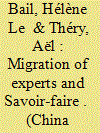|
|
|
Sort Order |
|
|
|
Items / Page
|
|
|
|
|
|
|
| Srl | Item |
| 1 |
ID:
091968


|
|
|
|
|
| Publication |
2009.
|
| Summary/Abstract |
Just as Spaghetti Westerns gained popularity in Thailand in the 1960s, so too did certain types of Italian cuisine, most notably macaroni and pizza. In present-day Bangkok, Italian food has come to dominate the lifestyle of the middle and upper-middle classes, albeit frequently adapted to Thai tastes: hence 'eastern spaghetti' and pizza tom yam kung, with tomato ketchup on the side. It is commonplace for national cuisines to be adapted on importation into another country. Besides, Thai diners do not appear to be particularly concerned with authenticity - so much so that one Italian restaurant in the Silom area, a business district of Bangkok, even placed a big banner in front of the building advertising 'inauthentic' or 'hybrid Italian food' under the slogan: 'Italian Food with Thai Flavour'. Moreover, the most revered foreign cuisine in Thai culinary history was not Italian but French (and to some extent English), dating from the two visits made by King Chulalongkorn to Europe in 1897 and 1907. Nor does the current 'Italmania' for food in Thailand come as a result of close diplomatic ties with Italy, but rather as a consequence of the popularity of Italian food in the UK and the USA, dating especially from the era of the Vietnam War. However, no matter how much Thais might love Italian cuisine, they prefer not to eat it on a daily basis, and many feel it to be too rich and greasy [lian], especially when living abroad with less access to familiar Thai dishes. Just as Chulalongkorn brought his own food supplies with him to Europe, so too do outbound Thai tour guides carry chilli paste and fish sauce. Former Thai Prime Minister Khukrit Pramoj summed up the experience of travelling abroad by noting that as a Thai he wanted rice, not bread. Of all the aspects of human behaviour, food habits are among the most difficult to change; nevertheless, change they do. Thais, especially the elite, do not have a 'monotheistic cuisine'. If one can pay respect to Brahminism, animism, Buddhism, monarchism and Christianity, then one can also eat a variety of foreign foods.
|
|
|
|
|
|
|
|
|
|
|
|
|
|
|
|
| 2 |
ID:
158298


|
|
|
|
|
| Summary/Abstract |
This article focuses on the practice of French cuisine in Shanghai and questions the permanence of this professional niche. It combines an anthropological approach to culinary techniques with a sociological approach to workforce migration, tracing the ways in which the discourse and practices of chefs and maîtres d’hôtel working in French cuisine’s restaurants employ forms of ethnocultural and technical legitimacy. The case of Shanghai, a city undergoing rapid transformation in its modes of consumption, provides a clear illustration of the shifts that have occurred over the last ten years in the hierarchy of Western migrants and Chinese locals: the symbolic and material privileges offered to the former are beginning to disappear, and professional recognition is increasingly becoming based on savoir-faire and a strong work ethic.
|
|
|
|
|
|
|
|
|
|
|
|
|
|
|
|
|
|
|
|
|